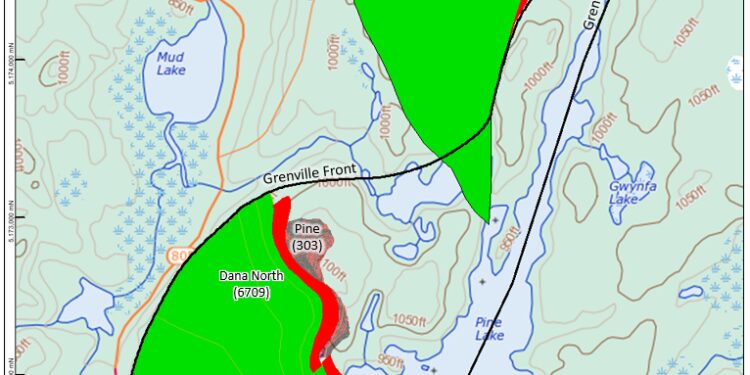New Age Metals Inc. (TSXV:NAM); (OTC:NMTLF) has completed Phase 2 of an ongoing Rhodium (Rh) assay programme on the River Valley Palladium Deposit near Sudbury, Ontario.
Phase 2 of the Rh assay programme collected 185 one-quarter historical core samples plus two coarse reject samples from eight mineralised intervals in four drill holes on a single cross-section through the Lismer North Zone. This Zone is located near the north end of the 16 km-long River Valley Palladium Deposit. The sampled holes were drilled in 2001 and 2004.
In addition to Rh, the core samples were also assayed for gold (Au), iridium (Ir), palladium (Pd), platinum (Pt), and ruthenium (Ru). The assay analyses were completed at the Geoscience Laboratories in Sudbury.
The new Rh data is in addition to historical data generated from drill core, channel and surface grab samples from the River Valley Deposit.
Rh is the most valuable platinum group metal (PGM), with recent spot price highs of over $US12,000/oz Rh, about 10 times higher than Pt. However, Rh analyses are too costly to be performed on every drill core assay sample. Rh is reported in the current Mineral Resource Estimate for the River Valley Deposit, based on regression analysis of historical drill core and channel sample assay data for the Dana North, Dana South and Lismer Zones.
The purpose of the multi-phase Rh assay programme is three-fold:
1. Investigate Rh concentration and distribution trends within the River Valley Deposit;
For this study of the Lismer North Zone, the Rh assay values returned range from <0.00005 g/t (below the lower limit of detection) to 0.565 g/t Rh. Eight samples returned assays of ≥ 0.100 g/t Rh and 25 samples returned assays higher than 0.050 g/t Rh. The highest assay result for Ir is 0.113 g/t and for Ru is 0.088 g/t.
Compared to the other mineralised zones, the range of Rh assay values for Lismer North Zone appears to be most similar to the Dana North Zone. Rhodium at the Lismer North Zone was determined for a total of 187 samples, 33 of which were for mineralised core intervals with historical Rh assay results and 154 were for intervals lacking Rh assays.
The re-assay results for the 33 historical samples show moderately strong positive correlation with the historical Rh assay results (Rh R2 = 0.714).
At this point, Rh assay data are available for 654 out of a total of 10,719 (6%) drill core samples from that Zone. The results show moderate to strong positive correlation of Rh with the other four PGM (R2 >0.7 to 0.9), consistent with presence in the mineral phases Hollingworthite [(Rh,Pt,Pd)AsS], platarsite [(PtAsS) with minor Rh and Ru), and laurite [(RuS2 with minor Rh], which have all been identified in previous mineralogical studies of River Valley.
In contrast to the Pine Zone, Rh shows only weak correlation (R2 >0.3) with copper (Cu) and very weak correlation (R2 >0.2) with nickel. On the other hand, and like the Pine Zone, Rh (and Ru) do not correlate with chromium (Rh R2 = 0.001 and Ru R2 = -0.016), and therefore is unlikely to be held in Cr-bearing phases like chromite.
The evident occurrence of Rh independently of chromite differs from other Rh-bearing PGM deposits elsewhere, and could potentially simplify metallurgical recovery processes. Similarly, the presence of laurite may bode well for potential Ru recovery.
2) Develop a more robust regression technique to estimate Rh concentrations from Pt grades for future Mineral Resource Estimates;
Statistical analysis indicates that Rh values for the remaining 10,123 samples from the Lismer North Zone can be estimated on the basis of Pt values through regression analysis (Pd values too commonly exceed the upper limit of detection). Results of this study indicate that Rh concentrations in the Lismer North Zone are equivalent to be approximately 11% of the Pt grades.
Statistical analysis indicates that Rh values for the remaining River Valley Deposit can be estimated on the basis of Pt values through regression analysis.
3) Investigate the potential of Rh as payable metal at River Valley
In order to complete the study, subsequent phases of work will take samples of PGM mineralised intervals from additional mineralised zones to establish and confirm the spatial distribution of rhodium, where practical, throughout the River Valley Deposit. Specifically, the mineralised zones selected to be studied next include Dana South and Lismer Ridge. Rhodium recovery testwork will be included in ongoing metallurgical studies, in order to determine whether Rh could be a payable metal for a potential PGM mining operation at River Valley. Non-linear regression models will also be investigated for more robust prediction of Rh contents, particularly higher values, where assays are not available.
Rhodium
Rh is the rarest and most valuable of the PGMs. The main use for Rh is in catalytic converters designed to clean vehicle emissions. This metal is particularly effective in cleaning nitric oxide emissions from internal combustion engine vehicles. The majority of Rh is produced as a by-product of platinum mining in South Africa. South Africa is the world’s largest producer of Rh (~80%), followed by Russia (~10%), Zimbabwe (~5%), Canada (~2%) and the USA (~2%).
The global average mineral resource/reserve grade is 0.281 g/t Rh, with the lowest reported mineral resource/reserve grade of 0.010 g/t Rh and the highest reported mineral resource/reserve grade of 0.381 g/t Rh.
For further information please visit: https://newagemetals.com/












